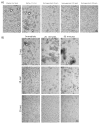Rapid measurement of macronutrients in breast milk: How reliable are infrared milk analyzers?
- PMID: 24912866
- PMCID: PMC5050037
- DOI: 10.1016/j.clnu.2014.05.005
Rapid measurement of macronutrients in breast milk: How reliable are infrared milk analyzers?
Abstract
Background & aims: Significant biological variation in macronutrient content of breast milk is an important barrier that needs to be overcome to meet nutritional needs of preterm infants. To analyze macronutrient content, commercial infrared milk analyzers have been proposed as efficient and practical tools in terms of efficiency and practicality. Since milk analyzers were originally developed for the dairy industry, they must be validated using a significant number of human milk samples that represent the broad range of variation in macronutrient content in preterm and term milk. Aim of this study was to validate two milk analyzers for breast milk analysis with reference methods and to determine an effective sample pretreatment. Current evidence for the influence of (i) aliquoting, (ii) storage time and (iii) temperature, and (iv) vessel wall adsorption on stability and availability of macronutrients in frozen breast milk is reviewed.
Methods: Breast milk samples (n = 1188) were collected from 63 mothers of preterm and term infants. Milk analyzers: (A) Near-infrared milk analyzer (Unity SpectraStar, USA) and (B) Mid-infrared milk analyzer (Miris, Sweden) were compared to reference methods, e.g. ether extraction, elemental analysis, and UPLC-MS/MS for fat, protein, and lactose, respectively.
Results: For fat analysis, (A) measured precisely but not accurately (y = 0.55x + 1.25, r(2) = 0.85), whereas (B) measured precisely and accurately (y = 0.93x + 0.18, r(2) = 0.86). For protein analysis, (A) was precise but not accurate (y = 0.55x + 0.54, r(2) = 0.67) while (B) was both precise and accurate (y = 0.78x + 0.05, r(2) = 0.73). For lactose analysis, both devices (A) and (B) showed two distinct concentration levels and measured therefore neither accurately nor precisely (y = 0.02x + 5.69, r(2) = 0.01 and y = -0.09x + 6.62, r(2) = 0.02 respectively). Macronutrient levels were unchanged in two independent samples of stored breast milk (-20 °C measured with IR; -80 °C measured with wet chemistry) over a period of 14 months.
Conclusions: Milk analyzers in the current configuration have the potential to be introduced in clinical routine to measure fat and protein content, but will need major adjustments.
Keywords: Fat; Freeze thaw cycle; Lactose; Protein; Stability; Validation study.
Copyright © 2014 The Authors. Published by Elsevier Ltd.. All rights reserved.
Conflict of interest statement
The authors have no potential conflicts of interest.
Figures











Similar articles
-
Comparing human milk macronutrients measured using analyzers based on mid-infrared spectroscopy and ultrasound and the application of machine learning in data fitting.BMC Pregnancy Childbirth. 2022 Jul 14;22(1):562. doi: 10.1186/s12884-022-04891-w. BMC Pregnancy Childbirth. 2022. PMID: 35836199 Free PMC article.
-
Milk analysis using milk analyzers in a standardized setting (MAMAS) study: A multicentre quality initiative.Clin Nutr. 2020 Jul;39(7):2121-2128. doi: 10.1016/j.clnu.2019.08.028. Epub 2019 Sep 3. Clin Nutr. 2020. PMID: 31526612
-
Validation of Correction Algorithms for Near-IR Analysis of Human Milk in an Independent Sample Set-Effect of Pasteurization.Nutrients. 2016 Feb 26;8(3):119. doi: 10.3390/nu8030119. Nutrients. 2016. PMID: 26927169 Free PMC article.
-
Establishment of micromethods for macronutrient contents analysis in breast milk.Matern Child Nutr. 2015 Oct;11(4):761-72. doi: 10.1111/mcn.12053. Epub 2013 Jun 18. Matern Child Nutr. 2015. PMID: 23782538 Free PMC article.
-
Effect of Freezing and Thawing on Human Milk Macronutrients and Energy Composition: A Systematic Review and Meta-Analysis.Breastfeed Med. 2020 Sep;15(9):559-562. doi: 10.1089/bfm.2020.0193. Epub 2020 Jul 17. Breastfeed Med. 2020. PMID: 32700962
Cited by
-
Optical properties of human milk.Biomed Opt Express. 2019 Jul 17;10(8):4059-4074. doi: 10.1364/BOE.10.004059. eCollection 2019 Aug 1. Biomed Opt Express. 2019. PMID: 31452995 Free PMC article.
-
Expressed Breast Milk Analysis: Role of Individualized Protein Fortification to Avoid Protein Deficit After Preterm Birth and Improve Infant Outcomes.Front Pediatr. 2022 Jan 13;9:652038. doi: 10.3389/fped.2021.652038. eCollection 2021. Front Pediatr. 2022. PMID: 35096699 Free PMC article.
-
Development of home-based methods to defat human milk for infants with chylothorax: An experimental study.JPEN J Parenter Enteral Nutr. 2025 Aug;49(6):724-731. doi: 10.1002/jpen.2782. Epub 2025 Jun 23. JPEN J Parenter Enteral Nutr. 2025. PMID: 40551440 Free PMC article.
-
Accuracy and Reliability of Infrared Analyzers for Measuring Human Milk Macronutrients in a Milk Bank Setting.Curr Dev Nutr. 2019 Oct 21;3(11):nzz116. doi: 10.1093/cdn/nzz116. eCollection 2019 Nov. Curr Dev Nutr. 2019. PMID: 31723725 Free PMC article.
-
Comparing human milk macronutrients measured using analyzers based on mid-infrared spectroscopy and ultrasound and the application of machine learning in data fitting.BMC Pregnancy Childbirth. 2022 Jul 14;22(1):562. doi: 10.1186/s12884-022-04891-w. BMC Pregnancy Childbirth. 2022. PMID: 35836199 Free PMC article.
References
-
- Lucas A, Cole TJ. Breast milk and neonatal necrotising enterocolitis. Lancet. 1990;336:1519–23. - PubMed
-
- Maggio L, Costa S, Gallini F. Human milk fortifiers in very low birth weight infants. Early Hum Dev. 2009;85:S59–61. - PubMed
-
- Lemons JA, Moye L, Hall D, Simmons M. Differences in the composition of preterm and term human milk during early lactation. Pediatr Res. 1982;16:113–7. - PubMed
-
- Polberger S. New approaches to optimizing early diets. Nestle Nutr Workshop Ser Pediatr Program. 2009;63:195–208. - PubMed
-
- Lonnerdal B. Personalizing nutrient intakes of formula-fed infants: breast milk as a model. Nestle Nutr Workshop Ser Pediatr Program. 2008;62:189–203. - PubMed
Publication types
MeSH terms
Substances
Grants and funding
LinkOut - more resources
Full Text Sources
Other Literature Sources
Medical

